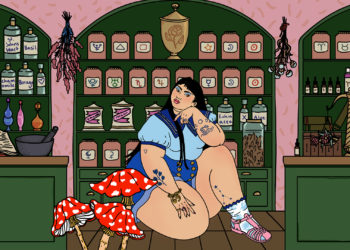The much-anticipated season finale of one of my favorite sitcoms was recently derailed when its creator, Shawna Lander, ran into a few snags. In the story I’ve been following for months, a peppy if scatterbrained woman named Jennifer McCallister has gone into labor after a pregnancy that’s transformed her relationship with her sister-in-law (also named Shawna) from antagonistic to amiable. Meanwhile, Jennifer’s mother, Barb — passive-aggressive to a comically villainous degree — is getting drunk on margaritas at a local Mexican restaurant and terrorizing the wait staff when she gets a call to meet Jennifer at the hospital.
But just as Jennifer was about to give birth, the story stopped. Lander announced that due to technical difficulties and illness, the audience would have to wait a few days to see what shenanigans Barb got up to, and whether this birth would help her and her son, Jennifer’s brother John, smooth over their rocky relationship. Illness foils shooting days all the time, but typically one creator’s bout of fever wouldn’t force audiences to wait well past the target air date to find out what happens. The difference with Lander’s show, which chronicles the ever-sprawling antics of the McCallister family — most sketches are actually stealth explorations of relationship dynamics — is that Lander is the show. She writes it. She produces and distributes it. She directs and shoots it.
And, most important, like several actors in hit TV shows, big-budget films and Tony-nominated Broadway productions this season, she plays every single character: Jennifer, Barb, Shawna, John, other male partners, assorted friends, the waitress, even Shawna’s two small children. They’re all Lander in wigs and different shirts, shot in close-cropped vertical framing for platforms like TikTok and Instagram, where she posts under the handle @shawnathemom. Her performances are so funny and specific that it’s shockingly easy to forget it’s all just her.
The McCallister family saga boasts considerable viewership. The chronicles are followed by two million TikTok users, with nearly a million more on Instagram. Add it up, and that’s a bigger audience than watched the Season 3 premiere of “The White Lotus.”
Lander’s format — playing every part herself, with shots framed and edited so the characters seem to be conversing with each other — involves a visual vocabulary familiar to comedians on vertical video platforms, who often post satirical sketches about corporate life or marriage. Just recently, a creator who goes by Sydney Jo posted the multi-episode “Group Chat” series, in which she played the multitudinous members of a friend group experiencing mounting drama over one girl’s boyfriend, culminating in a “Real Housewives”-style reunion episode. The series was such a viral hit that Sydney Jo was invited onto the “Today” show to talk about it.
The appeal of this breed of social media storytelling is partly in the writing, but it’s mostly in the performance. There’s something inherently mesmerizing about watching one person expertly don multiple personas. It’s not the low-fi costume changes that are so appealing. It’s the thrill of watching someone shape-shift, their facial features and mannerisms morphing and rearranging, inhabited by vastly different dispositions.
In 2025, actors on stages and screens galore have been all about multicharacter performances. There’s Anna Camp in the Netflix series “You,” and Blake Lively in “Another Simple Favor,” and Joshua Jackson in “Doctor Odyssey,” and Cynthia Erivo in “Poker Face.” Robert De Niro plays two characters in “The Alto Knights,” as does Theo James in “The Monkey,” and Robert Pattinson plays more than a few in “Mickey 17.” “Severance” gives much of the main cast an excuse to play multiple versions of the same person — one in the real world, one corporate drone. And, of course, there’s Michael B. Jordan as twins in “Sinners,” which is not just a huge hit with audiences but also shaping up to be one of those films we’re still talking about come awards season.
In the script, there’s no real reason for the Smokestack twins to both be Jordan, other than the spectacle of it; they could just be brothers, played by different actors. But they’re identical twins, and that’s significant, especially in a horror film that goes long on its otherworldly and freaky elements. As history and the soap opera tradition of secret evil twins shows, the human mind tends to find something uncanny and disturbing about identical twins. Some cultures have feared twins, suspecting dark forces at work. Some have developed a dread of spotting one’s doppelgänger, a harbinger of impending death. The sight of two people with the same face tickles something visceral inside us, and that’s true on the screen as well.
None of this is new in entertainment. Entranced by the possibilities that camera trickery allows, double (or more) performances have been part of film and TV almost since the dawn of movies. A number are now classics, from Peter Sellers in “Dr. Strangelove” and Hayley Mills (and later Lindsay Lohan) in “The Parent Trap” to most of the main cast of “Back to the Future Part II.” There’s Jeremy Irons in “Dead Ringers” and Christian Bale in “The Prestige,” Tatiana Maslany in “Orphan Black” and James McAvoy in “Split.” Nicolas Cage received an Oscar nomination for playing twins in “Adaptation,” and also sort of did it in “Face/Off,” alongside John Travolta. (Technically Kim Novak didn’t play two roles in “Vertigo,” but you’d be forgiven for remembering it that way.)
The multicharacter format also persists because, in practical terms, it’s a good way to garner critical acclaim, if you do it right. The performer gets a built-in showcase, a way to demonstrate versatility and range.
Such is the case with both Andrew Scott, who takes on all eight characters in his Off Broadway one-man “Vanya,” and Sarah Snook, who plays a staggering 26 roles in the Broadway production of “The Picture of Dorian Gray.” Snook’s performance, which was nominated for a Tony on Thursday, has been particularly buzzy; watching it prompts a feeling not wholly unlike the astonishment that comes from watching a virtuosic Olympic gymnast. She’s working at full throttle, switching accents and attitudes, talking nonstop, running around, changing costumes for two hours, no intermission. To many audiences, who know her primarily as the competitive but damaged Shiv Roy from “Succession,” it’s a revelation. I was exhausted for her by the end — and I saw the second performance of the day.
“Dorian Gray” makes ample use of screens hanging from the ceiling, oriented in a phone-like portrait mode, onto which pretaped performances are projected. Sometimes several Snooks appear onscreen; sometimes the onstage Snook plays off them, creating a spectacle that resembles, slightly and not entirely accidentally, the kind of multicharacter tableau that Lander and other creators make use of on TikTok. Midway through the show, Snook’s Dorian Gray becomes obsessed with his phone, and with applying filters to change his appearance, zazzing it up, transforming himself into a being that’s more what might be called yassified. He has, in essence, created a digital doppelgänger of himself. If you know the story, you know it is not unrelated to his own death. Perhaps, the play suggests, the vanity of the internet has turned us all into multicharacter performers.
Alissa Wilkinson is a Times movie critic. She’s been writing about movies since 2005.
The post When One Actor Contains Multitudes: An Old Form Finds (Eerie) New Life appeared first on New York Times.




